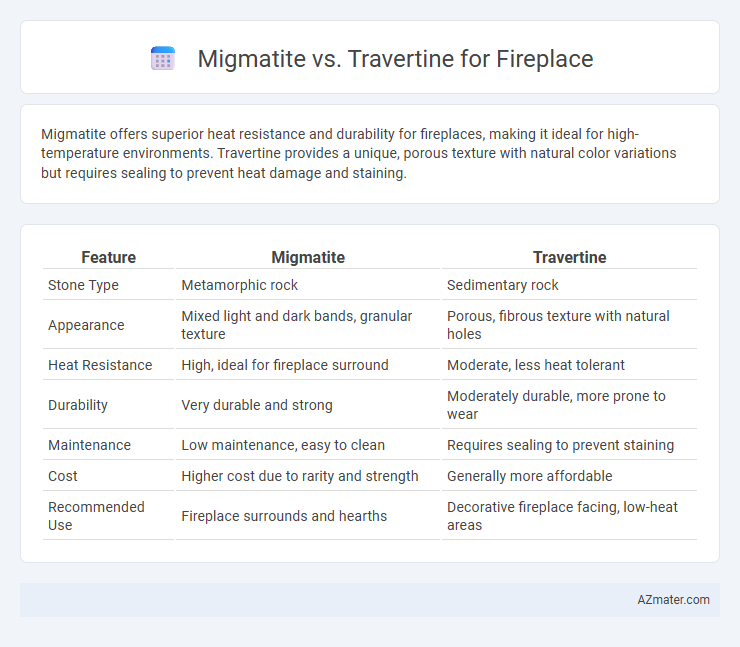Migmatite offers superior heat resistance and durability for fireplaces, making it ideal for high-temperature environments. Travertine provides a unique, porous texture with natural color variations but requires sealing to prevent heat damage and staining.
Table of Comparison
| Feature | Migmatite | Travertine |
|---|---|---|
| Stone Type | Metamorphic rock | Sedimentary rock |
| Appearance | Mixed light and dark bands, granular texture | Porous, fibrous texture with natural holes |
| Heat Resistance | High, ideal for fireplace surround | Moderate, less heat tolerant |
| Durability | Very durable and strong | Moderately durable, more prone to wear |
| Maintenance | Low maintenance, easy to clean | Requires sealing to prevent staining |
| Cost | Higher cost due to rarity and strength | Generally more affordable |
| Recommended Use | Fireplace surrounds and hearths | Decorative fireplace facing, low-heat areas |
Introduction to Migmatite and Travertine
Migmatite is a metamorphic rock characterized by its mixed composition of igneous and sedimentary materials, offering exceptional strength and unique swirling patterns ideal for durable fireplace surrounds. Travertine, a sedimentary rock formed from mineral deposits in hot springs, features a porous texture and warm, earthy tones that bring a natural elegance to fireplace designs. Choosing between Migmatite and Travertine depends on desired aesthetics, durability, and heat resistance for optimal fireplace functionality.
Geological Origins of Migmatite and Travertine
Migmatite forms through high-grade metamorphism where intense heat partially melts pre-existing rocks, resulting in a hybrid of igneous and metamorphic textures that provide durability and unique variegated patterns for fireplace surrounds. Travertine originates from the rapid precipitation of calcium carbonate in mineral-rich hot springs or limestone caves, creating a porous and naturally textured stone favored for its warm, earthy tones. The contrasting geological origins explain migmatite's dense and interlocking crystal structure versus travertine's layered, sedimentary appearance, influencing their heat resistance and aesthetic appeal in fireplaces.
Aesthetic Differences: Color and Texture
Migmatite exhibits a complex fusion of igneous and metamorphic characteristics with swirling patterns and a broad spectrum of colors ranging from creamy beige to deep gray, creating a visually dynamic and intricate texture ideal for a natural, earthy fireplace aesthetic. Travertine, known for its warm, neutral tones such as tan, ivory, and soft gold, offers a distinct porous surface with natural pitting and veins that provide a soft, rustic elegance and a more uniform appearance. The choice between migmatite and travertine for a fireplace ultimately hinges on a preference for the dramatic, variegated look of migmatite versus the classic, smooth, and warm ambiance of travertine.
Durability and Heat Resistance
Migmatite, a sturdy metamorphic rock, offers superior durability and excellent heat resistance, making it ideal for fireplace surrounds exposed to high temperatures. Travertine, a sedimentary limestone, is less heat-resistant and more porous, requiring sealing to prevent heat damage and staining. For long-lasting performance under intense heat, migmatite provides a more reliable and resilient option compared to travertine.
Maintenance and Cleaning Requirements
Migmatite fireplaces require periodic sealing to protect against stains and moisture, with cleaning methods involving mild soap and water to avoid damaging its unique mineral layers. Travertine fireplaces demand regular sealing as well, due to their porous nature, and should be cleaned gently with pH-neutral cleaners to prevent surface etching and discoloration. Both materials benefit from routine dusting and immediate removal of spills to maintain their natural beauty and durability.
Cost Comparison: Migmatite vs Travertine
Migmatite offers a mid-range cost option for fireplaces, typically ranging from $30 to $60 per square foot, influenced by its unique blend of metamorphic patterns. Travertine tends to be more affordable, with prices averaging between $20 and $50 per square foot, making it a budget-friendly choice for natural stone fireplaces. Cost variations depend on factors such as stone quality, sourcing location, and installation complexity for both Migmatite and Travertine.
Installation Considerations
Migmatite offers a durable, heat-resistant surface ideal for fireplaces, requiring professional installation to handle its dense, heavy slabs and precise cutting techniques. Travertine, while aesthetically pleasing with its porous texture and warm tones, demands sealing and careful handling to prevent staining and damage during installation. Both materials need proper substrate preparation and fastening methods to ensure long-term stability and safety in fireplace construction.
Environmental Impact and Sustainability
Migmatite is a natural metamorphic rock with high durability, often quarried with minimal chemical processing, resulting in a lower carbon footprint compared to engineered stones. Travertine, a form of sedimentary limestone, undergoes substantial quarrying and finishing processes that may contribute to habitat disruption and increased energy consumption. Choosing migmatite for fireplaces supports sustainability by utilizing a more eco-friendly material with reduced environmental impact throughout extraction and manufacturing.
Design Flexibility for Fireplace Applications
Migmatite offers exceptional design flexibility for fireplace applications due to its unique blend of metamorphic textures and rich, variegated patterns that create a striking visual impact. Travertine provides a more uniform, classic stone appearance with a warm, natural color palette, easily complementing traditional and contemporary fireplace styles. Migmatite's durability and ability to be polished or textured allow for more customized shapes and finishes compared to the softer, porous nature of Travertine, which may require sealing and more maintenance.
Pros and Cons of Migmatite and Travertine for Fireplaces
Migmatite offers exceptional durability and heat resistance, making it ideal for fireplace surrounds that endure frequent temperature changes; its unique, swirling patterns also provide a distinctive aesthetic appeal. Travertine, while visually appealing with its warm tones and natural pores that can be filled for a smooth finish, is less heat-resistant and more prone to staining or chipping, requiring regular sealing and maintenance. Choosing between migmatite and travertine depends on prioritizing either robust performance and longevity or softer, classic beauty with ongoing care considerations.

Infographic: Migmatite vs Travertine for Fireplace
 azmater.com
azmater.com